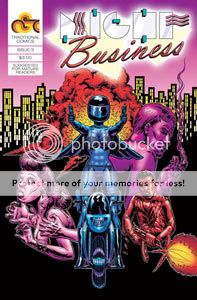* Today at Marvel.com I interviewed Chip Kidd about his cover design for the Strange Tales hardcover. Man, what a pleasure that guy is to talk to. He talks about his comic cover design philosophy, Marvel vs. DC, how he finds projects…enjoyable stuff.
* Diamond is changing its policy regarding minimum orders so that they’ll still fulfill orders for an item that falls short, only canceling related future issues. So you can still get your foot in the door. It’s still more of a hatchet than a scalpel, in the parlance of our times, but it’s a step in the right direction.
* Chris Ware is going to C2E2. ROAD TRIP
* Tom Spurgeon reviews Afrodisiac. He’s right–this book could have simply coasted, but Rugg and Maruca chose otherwise.
* My main takeaway from Marvel’s official Heroic Age/Avengers announcement is that it appears Gorilla Man from the Agents of Atlas is joining the Avengers. More, but alas not more about Gorilla Man, at USA Today and CBR.
* Bout of Geekery #1: The fact that neither CBR nor USAT actually listed the characters depicted in the promo art indicates to me that maybe this line-up isn’t really the line-up. Regardless, it’s Thor, Iron Man, Bucky Barnes as Captain America, Spider-Man, Hawkeye, the Thing, Beast, Black Widow, and Gorilla Man. It’s interesting to me that after all the to-do about getting the Big Three Avengers back together, this team gets Bucky Cap rather than Steve Rogers. Also interesting: a bit of a sausagefest, no? Also also interesting: It’d be cool if the Thing, Beast, and Gorilla Man were there as official representatives for their respective teams, the Fantastic Four, the X-Men, and the Agents of Atlas. That seems like a geekily logical way to build teams like the Avengers and the Justice League. Heck, by that light you could see Black Widow as an agent of SHIELD, and even Spidey as a liaison from the New York City street-level dudes. Also, I could be wrong, but I don’t see a lot of potential for intra-team conflict in that line-up. That’s a bunch of get-along guys, for the most part.
* Hahaha that Saw guy is really pissed They’re making him do another Saw movie instead of Paranormal Activity 2. Like, talking shit about the movie he’ll be directing for the next few months and everything. Awesome.
* This is indeed a fine piece on Lady Gaga by the great Rich Juzwiak. Locating her as the fulfilled prophecy of electroclash was a nice touch, as was examining the role of mystery and mythmaking among young listeners, something I wasn’t sure was even possible anymore in the Internet age. If anything I think Juzwiak’s a little hard on her regarding her philosophical pontifications–I mean, Bowie was all over the fucking place in his provocateur days any time he ventured much further than talking about rock music, and no one holds that against him, or no one should. (Via Pitchfork.)
* Bout of Geekery #2–Extreme Edition: Ben Morse selects his Marvel Lanterns. Here are mine:
Red = Wolverine
Orange = Doctor Doom
Yellow = Green Goblin
Green = Spider-Man
Blue = Captain America
Indigo = Professor X
Violet = Cyclops
Black Lantern Avatar = The Punisher
Black Lantern Guardian = Thanos
This wasn’t all that easy.
Ben picked the Hulk for Red, and obviously that’s a great choice, but a) I wanted Wolverine on here, and b) there’s already a Red Hulk so the visual impact wouldn’t be as strong. Berserker Wolverine’s just as logical a choice.
I thought about making Doctor Doom Yellow, since I think he needs to be the A-Number-1 supervillain for Marvel and should scare the shit out of the heroes any time he shows up, but his lust for power, knowledge, and the kudos Reed Richards got instead of him makes him a prime Orange candidate.
I picked the Green Goblin for Yellow to get him back to his scary crazy Halloween-costume roots (something I think that Brian Bendis/Michael Lark mask sequence in the Siege prologue issue did very well, by the way).
I imagine Spidey as the Green Lantern leaves some folks scratching their heads, but a) making the flagship Marvel character the flagship Lantern makes sense on a meta level; b) Spidey is all about overcoming great fear and adversity. The Corps could rest assured he’d use his power responsibly, duh. Plus I think you could get some neat power-ring-as-web-shooter visuals out of it.
Cap’s a no-brainer for Blue.
I wanna see Professor X get back to being the Martin Luther King of the Marvel Universe, instead of a slaveowner who covers up multiple murders routinely, so Indigo for him.
Cyclops seems like a character defined by his relationships, first with Phoenix and now with Emma Frost, so it’s Violet for him. If you insisted on having a woman in this role since we haven’t seen any male Star Sapphires yet, I think it’d be an interesting commentary on Emma to give it to her, implying that her feelings for Scott are really real and have really changed her. Plus, she’s pretty much already there, outfit-wise; you’d just have to change the color scheme.
It ain’t rocket science making the Punisher the Black Hand of the Marvel Universe–he’s cheated death twice, and the more-or-less in-continuity Garth Ennis origin story Born literally had him make a deal with Death for eternal life in exchange for being able to routinely murder people, so he’s already halfway there if not more. And Thanos as Nekron = obvs.
For reference, here are my ideal DC Lanterns–I’ve changed the line-up somewhat:
Red = Doomsday
Orange = Lex Luthor
Yellow = Batman
Green = Hal Jordan
Blue = Superman
Indigo = Steel
Violet = Wonder Woman
I’ve come around on making Wonder Woman Violet/Love, rather than my initial idea of Green/Will. Seems to me that part of what makes Wonder Woman dull these days is this a very joyless interpretation of what a tough superheroine warrior woman would be like. Tapping into her as some embodiment of love for humanity might lighten and liven her up a bit. If they lost the bare midriff from the costume, I wouldn’t mind it at all. Plus, this way the marquee power of the line-up is stronger than when I had Hal out altogether and Kyle Rayner in the Violet slot.




